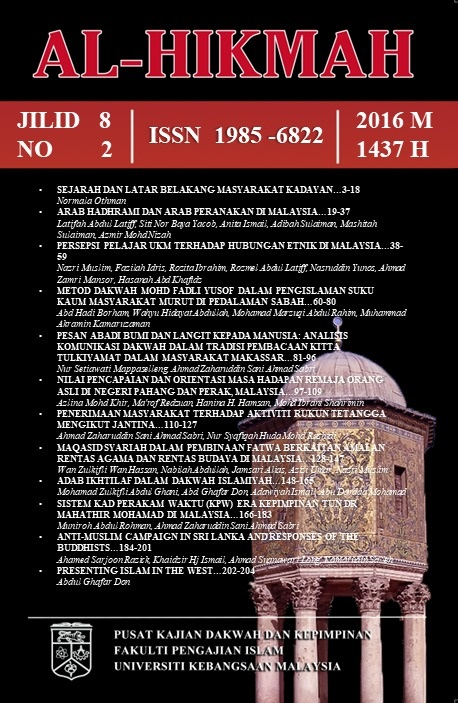HISTORY AND BACKGROUND OF THE KADAYAN COMMUNITY
Sejarah dan Latar Belakang Masyarakat Kadayan
Abstract
The Kadayan community is one of the indigenous communities that can be found in the larger parts of Borneo Island; in Sabah, W.P Labuan, Sarawak and Brunei. Their major settlements in Sabah are concentrated in Sipitang and Papar while in Sarawak, the Kadayan community can be found in Limbang, Lawas, Miri, Sibuti and Bintulu. The Kadayan are said to be amongst the earliest inhabitants in Brunei. During the reign of Sultan Bolkiah (1485-1524), Brunei had vast colonies that spread between the Island of Borneo to the Sulu Archipelago. The greatness of the Brunei empire allowed the migration of people from Brunei to their territories. The Kadayan community have the same physical characteristics as the Brunei-Malays. They converse in the Kadayan dialect which is under the Malay language family. The traditional life of the Kadayan community is closely related to agriculture and cultivation of rice is their main economic activity. Thus, this article will discuss their unique traditional heritage and how far they have preserved their heritage to this day.
References
Amde Sidik. 2007. The Mystic of Borneo. Kota Kinabalu: Borneo Publisher.
Asmah Hj.Omar. 1988. Susur Galur Bahasa Melayu. Kuala Lumpur: Dewan Bahasa dan Pustaka.
Awang Muhammad Jambol. 1995. Fonologi Bahasa Kedayan. Bandar Seri Begawan: Dewan Bahasa dan Pustaka.
Bantong Antaran. 1995. Brunei Dress: Tradition and Adaptation. The Brunei Museum Journal, Volume 10: 1-13.
Baszley Bee, Sabihah Osman, Nordin Sakke. 2009. Asas Kajian Persempadanan Negeri Sabah. Kota Kinabalu, Sabah: Universiti Malaysia Sabah.
Binchin, P. 1992. Masalah Pengkajian Etnik di Borneo dan Pengajarannya bagi Negara Brunei Darussalam. The Brunei Museum Journal Vol. 7, No. 4: 49-55.
Brown, D.E. 1970. Brunei : the structure and history of a Bornean Malay Sultanate. Brunei: Brunei Museum.
Grenier, L. 1998. Working With Indigenous Knowledge : A Guide For Researchers. Canada: International Development Research Centre.
Jaludin Chuchu. 2003. Dialek Melayu Brunei Dalam Salasilah Bahasa Melayu Purba. Bangi: Penerbit Universiti Kebangsaan Malaysia.
Julayhi Tani. 1991. Sosioekonomi Komuniti Kadayan: Satu Kajian Kes. Kuching: Dewan Bahasa dan Pustaka.
King, V.T. 1993. The Peoples of Borneo. Cambridge, Mass: Blackwell Publishers.
Leake, D. 1989. Brunei: The Modern Southeast-Asian Islamic Sultanate. North Carolina: McFarland & Co.
Low Kok On. 2009. Tradisi Lisan Keramat Tuanku Syarif Kedah di Pulau Labuan. Kota Kinabalu: Universiti Malaysia Sabah.
Malinowski, B. 1927. Sex and Repression in a Savage Society. London: Routledge & Kegan Paul.
Maxwell, Allen Richmond, JR. 1980. Urang Darat: an ethnographic study of the Kadayan of Labu Valley, Brunei. Disertasi Ph.D.Yale University, United States – Connecticut. Retrieved December 28, 2009, from Dissertations & Theses: Full Text. (Publication No. AAT 8109805).
P.M. Shariffuddin. 1969. The Kedayans. The Brunei Museum Journal Vol.1, No.1: 15-23.
P.M. Shariffuddin. 1970. ‘Makan Tahun’, The Annual Feast of the Kedayans. The Brunei Museum Journal Vol. 2, No, 1: 61-66.
Pg Ismail Pg Ibrahim. 1982. Permainan Gasing (Top Playing). The Brunei Museum Journal Vol.5, No.2: 105-118.
Ranjit Singh, D.S. 1991. Brunei 1839 – 1983, The Problems of Political Survival. Singapore: Oxford University Press.
Sather, C.A & Hatta Solhee. 1974. Kampung Selanyau Social and Economic Organization of a Kedayan Rice-growing Village in Sarawak. The Sarawak Museum Journal,Vol. XXII, No.43: 249-266.
Shanti Thambiah. 1995. Culture as adaptation: change among the Bhuket of Sarawak, Malaysia. Tesis Ph.D. Hull University.
© 2025 Al-Hikmah.
Copyright of the published article is vested in UKM Press, Universiti Kebangsaan Malaysia upon formal acceptance and completion of the copyright transfer agreement.
All articles are licensed under a Creative Commons Attribution–NonCommercial 4.0 International License (CC BY-NC 4.0), which permits non-commercial use, distribution and reproduction in any medium, provided the original work is properly cited.





